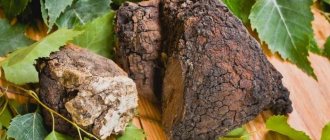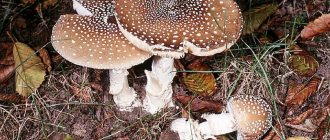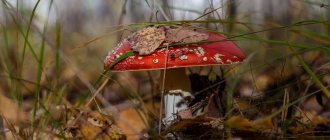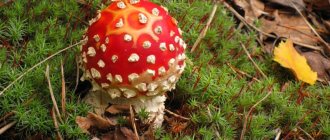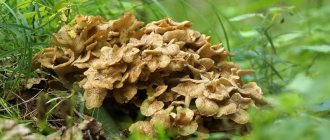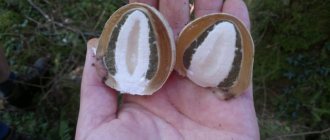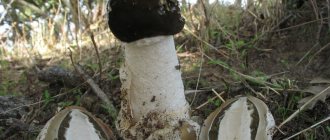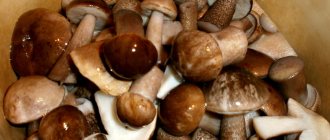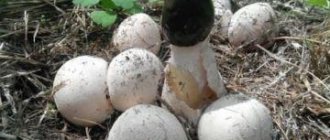The giant golovach or gigantic puffball is rightfully considered a heavyweight record holder in the world of mushrooms due to its size. This mushroom, which has a characteristic appearance, has excellent gastronomic properties, and is therefore very popular among mushroom pickers. Puffball is an edible mushroom, and you can eat it immediately after heat treatment, and you can also store it for future use: dry, freeze or can. However, the bighead has dangerous counterparts that are poisonous, so it is important to know their main signs to avoid food poisoning.
Description of the Giant Raincoat
Giant puffball (lat. Calvatia gigantea, Bovista gigantea, Langermannia gigantea, Lycoperdon giganteum) comes from the Golovach genus and belongs to the Champignon family. It has several names: Langermannia gigantea, Bovista gigantea, Giant powder. Listed in the Red Book of the Altai Territory (2006), the Red Book of the Altai Republic (2007), and Tatarstan (2009).
This is interesting! Golovach has the ability to process the remains of living beings, converting them into carbon-free compounds.
The large puffball, which can reach 35 cm in diameter, grows singly. Maximum weight: 10–25 kg. The structure is quite specific: it does not have a cap or stem, it is spherical.
Young mushrooms have snow-white flesh with a pleasant aroma. As it ages, it first turns yellow and then turns green. This specimen is unsuitable for food: the shell bursts and brown spores come out.
Edibility
Is this specimen edible or not? This is an edible variety. For the preparation of various dishes, only brand new young representatives are used, characterized by the purity and whiteness of the pulp. Culinary purposes are very diverse. As for the nutritional properties, they are equivalent to the properties of porcini mushroom. The pulp of a recently grown specimen can surpass the porcini mushroom in the amount of proteins.
In addition to the huge protein content, the composition of the golovach is full of vitamins, carbohydrates, micro- and macroelements. Gourmets value this dish very much because of its exquisite and unique taste. Heat treatment makes the forest product similar to processed cheese or tofu. It contains moisture, which makes it possible to save time on boiling when creating dishes. Can be boiled with a small amount of water. They are usually fried, created into delicious soups or mushroom powders.
Too old or overripe specimens should definitely be put aside and not eaten because they contain high amounts of toxic substances. Young bigheads cannot be stored for long periods of time, as in this case they tend to acquire harmful or even poisonous characteristics.
Growing at home and in the country
You can grow a giant puffball mushroom yourself and feed the whole family with the edible fruit. To do this, spores with mycelium are purchased in specialized stores for breeding.
Mycelium is a fungal body in a vegetative state. Consists of thin threads with branches (hyphae).
Choose a shady place for planting: under trees and shrubs. The main condition is that the air temperature in this place should fluctuate between 14–29 °C. Of course, with the exception of winter time. A month after planting, the mushroom bears fruit every 20 days. Caring for the garden bed is easy: you only need watering to keep the soil moist.
How to grow:
- Loosen the planting area.
- Scatter the spores evenly.
- Cover the area with a layer of earth (about 7 cm).
- Water the garden bed thoroughly.
WHO ARE GASTEROMYCETES
Giant puffballs belong to the gasteromycetes, a non-systematic group of fungi with closed fruiting bodies. This group includes about a thousand species belonging to more than a hundred genera. Some gasteromycetes lead a parasitic lifestyle, while the majority, like the giant bighead, are saprophytes. They are able to process dead remains of living beings, turning them into inorganic compounds. Representatives of Gasteromycetes are found everywhere, but the most exotic species, characterized by unusual coloring and shape, are more often found in tropical countries. The golovach grows almost everywhere, but in the middle zone it can be found most often.
This is what an overripe fruiting body of a bighead mushroom looks like: the fallen off shell reveals a loose brown mass (glebe) of the fungus.
False doubles
There is a false mushroom that looks very similar to the giant bighead. It's called False Raincoat. It is not poisonous, but it is not recommended to eat it: it has an extremely unpleasant taste and smell.
Take a look at the photo: it is much darker than Calvatia gigantea.
| Giant raincoat | False raincoat | |
| Flesh color | White | Deep purple |
| Outer shell | Thin | Leathery, dense |
| Mushroom body color | Light, darkens with age | Dark from the start |
| Spore mass | Soft | Dense |
General information about the mushroom
The fruiting body of the giant bighead is round in shape. At the bottom of this huge “head” is a thin stalk consisting of an interlacing of fungal hyphae. Golovach, like most other mushrooms, forms mycorrhiza with the roots of trees growing nearby. The top of the fruit body is covered with thin white skin. Over time, it, like the snow-white pulp of the raincoat, acquires a brownish tint. Young bigheads can be eaten - their flesh looks like cotton wool, but has a characteristic taste and smell.
Connoisseurs claim that this mushroom is especially tasty when fried. Having decided to try this delicacy, it is worth remembering that it is better to eat it within 24 hours after collection, otherwise the mushroom will become unsuitable for food. If a raincoat found in the forest has already acquired a greenish or brown color, it is not worth collecting and preparing it. In a mature mushroom, the outer shell darkens and soon bursts, thus releasing millions of brown spores.
What does a bighead look like?
hat
The mushroom does not have legs or caps as such; it has a spherical or ovoid fruiting body, sometimes flattened. The mushroom can grow to impressive sizes - 50 cm in diameter and 20 kg in weight. The body of the giant bighead is covered with two smooth shells. The outer shell of the mushroom is thin and brittle, cracking quickly. Beneath it there is a second, thick shell, but also prone to cracking.
Bighead's hat.
Pulp
The flesh of the young mushroom is white, then it becomes greenish-yellow, and when the mushroom is fully ripe, it becomes olive-brown. Also, as it matures, the surface of the giant bighead (Calvatia gigantean) also turns brown. The mushroom is widespread in Russia, especially in the European part, but it also grows in some regions of southern Siberia, the Far East, and Karelia.
Evaluation of taste qualities, medicinal properties, benefits and possible harm
The giant bighead mushroom contains the substance calvacin. In traditional medicine recipes, medications are created on its basis. It helps in the treatment of kidneys, laryngitis, urticaria, leukemia and tumors. Present in the flu vaccine.
This is interesting! A medicinal mushroom cut into two parts promotes wound healing.
In medical laboratories, spores are isolated from raincoats and effective drugs are created based on them. They are used for diabetes, bronchial asthma, tuberculosis, pleurisy, and women's diseases. They remove toxins and heavy metals from the body that are contained in the body of a person working or living in unfavorable conditions.
Avoid eating mushrooms under the following conditions:
- fruiting bodies are collected and grown near a highway, plant, factory;
- if you have kidney problems;
- during pregnancy and breastfeeding;
- if there is individual intolerance.
Location
Golovach can be found most often in the temperate zone. It grows one at a time, but once it appears in one place it can disappear for a long time. The Golovach mushroom is often called “meteor”. In Russia, you can often find this type of mushroom in the Krasnoyarsk Territory, Siberia, the Far East, and Karelia.
Grows in deciduous and mixed forests, steppes, pastures, fields and meadows. The “silent hunt” for the mushroom begins in July and ends with the arrival of the first frost.
Maximum yield is observed at the end of August. The mushroom is edible only when young, while its glebe is white, dense and elastic.
Interesting Facts
Did you have a dream that you were wandering through the forest and saw growing raincoats? The subconscious mind tells you: you have a very gentle nature and a subtle mental organization.
In the 19th century, raincoats were used by barbers and hairdressers. If they injured a client with scissors or a razor, they would apply a piece of a giant bighead to the wound of the victim. It was a popular hemostatic agent, so the cut healed quickly.
- The giant puffball is capable of growing to large sizes.
- The content of calvacin in the fruiting body makes Langermannia giant a medicinal product.
- Young puffballs can be used to prepare many delicious dishes.
Information sources
Garibova L.V., “In the kingdom of mushrooms” / Mushroom Encyclopedia | Author of the book - Vadim Archer / Mushrooms: Directory M. "Astrel", "AST" 2001 621—263 5-17-009961-4 / Gapienko O. S., Shaporova Y. A. Calvatia gigantea
// Red Book of Belarus, 2016 / Elin Yu. Ya., Zerova M. Ya., Lushpa V. I., Shabarova S. I. Dari lesiv. - Kiev: Harvest, 1979. - 440 p. / Zerova M. Ya., Elin Yu. Ya., Koz'yakov S. M. Mushrooms: natural, mentally natural, unnatural, destructive. - Kiev: Harvest, 1979. - P. 148–149.
What does an elongated bighead look like?
In the photo of the oblong bighead you can see a large mushroom that looks like a large mace or white skittle. The fruiting bodies are easy to spot on the forest floor due to their unusual shape. They often reach from 7 to 15 cm in height, under favorable conditions - up to 17-20 cm.
On the long leg of the oblong bighead there is a hemispherical apex
The fruiting body has thickenings (up to 7 cm) and narrower areas (2-4 cm). Young specimens are tobacco brown. With age, the surface becomes lighter and becomes covered with thorns of various sizes.
In the early stages of growth, the flesh of the oblong loggerhead is elastic in structure, but over time it becomes flabby and yellowish, and then turns into a brown powder.
The top of mature specimens completely crumbles, spores begin to be released, and the stalk itself remains intact for a long time
You can find detailed information about the mushroom in the video:
Features of the mushroom
The puffball - the giant bighead - has many features. This mushroom is very beneficial for the body. Its main feature is the absorption of radionuclides, as well as heavy metal salts. After eating a dish prepared from a raincoat, harmful substances quickly leave the body naturally.
It is worth noting that due to this property, golovach is used for the manufacture of dietary supplements. As practice shows, such products cleanse the body well, restore the skin and make it more elastic. If you wish, you can prepare a delicious dish from golovach at home.
Original flowering and other flower head talents
The western flowerhead (Cephalanthus occidentalis) is better known in our country under the name of the western flowerhead. The flower head in regions with harsh winters will not exceed one and a half meters in height, although in nature it looks much more powerful. The flower head is classified as an ornamental deciduous shrub of compact size. It is distinguished by the neatness and beauty of the crown, quite dense and openwork. In order to give the flowerhead a special beauty or maintain the spherical shape of the crown, you can resort to pruning, which this shrub tolerates surprisingly well.
Flowerhead shoots become dark with age and become covered with grooves; very large, up to 15 cm long, ovoid leaves with a beautiful light color look impressive on them. The veins of the leaves are colored, repeating the slightly reddish tint of the branches, making the whole bush look very original. The foliage of the bighead does not lose its color until mid-autumn, when all its neighbors have long since changed their outfit to crimson or gold.
But despite the beauty of the crown and leaves, flowering remains the main pride of the bighead. This species blooms in summer; during the entire half of the hottest time of the year, its shoots are crowned with bizarre spherical inflorescences of white tubular flowers with very long needle-shaped stamens. The radial arrangement of flowers in inflorescences creates the effect of a perfect sphere and fluffiness. The diameter of the inflorescences ranges from 3 cm; they seem even more original against the background of the large leaves of the bush.
Western flowerhead (Cephalanthus occidentalis)
Cooking recipes
3 easy and tasty recipes for cooking golovach.
Helpful Tips:
- do not cook with materials collected in contaminated areas;
- try to cook it right away so that it doesn’t sit too long;
- There is no need to cook it before cooking; it will lose its quality due to water.
Fried golovach mushroom
In sour cream
- Peel and wash vegetables and mushrooms.
- Cut the potatoes into slices. Cook with salt. When ready, drain the water.
- Chop the mushrooms and fry in oil (25 minutes over low heat).
- Fry the onion in half rings (separately).
- Add onion, boiled potatoes, salt and pepper to the golovach. Simmer for 15 minutes. on low heat.
- Add sour cream, stir and let simmer for 5 minutes.
- Sprinkle with herbs if desired.
Fried golovach mushroom
- Cut the washed, peeled mushroom into strips or cubes.
- Fry in oil. After 5–10 minutes. reduce heat.
- Chop onion, garlic and fry with mushrooms.
- There's also salt, pepper and sour cream.
- To cover with a lid.
- Sprinkle with herbs.
Cream soup
- Peel and wash potatoes, onions, carrots.
- Wash, peel and chop the mushrooms.
- Let the potatoes cook.
- Fry mushrooms, carrots, onions.
- Pour over potatoes and add olives.
- Let it simmer over medium heat.
- Grate the processed cheese.
- Add it to the pan, salt and pepper.
- Beat into a homogeneous mass. Sprinkle with finely chopped dill.
- Before serving, top with cream (optional).
